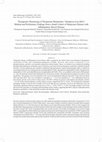Papers by Prof. Dr. Suzana Makpol

Frontiers in Pharmacology, Dec 10, 2023
Musculoskeletal health is paramount in an ageing population susceptible to conditions such as ost... more Musculoskeletal health is paramount in an ageing population susceptible to conditions such as osteoporosis, arthritis and fractures. Age-related changes in bone, muscle, and joint function result in declining musculoskeletal health, reduced mobility, increased risk of falls, and persistent discomfort. Preserving musculoskeletal wellbeing is essential for maintaining independence and enhancing the overall quality of life for the elderly. The global burden of musculoskeletal disorders is significant, impacting 1.71 billion individuals worldwide, with age-related muscle atrophy being a well-established phenomenon. Tocotrienols, a unique type of vitamin E found in various sources, demonstrate exceptional antioxidant capabilities compared to tocopherols. This characteristic positions them as promising candidates for addressing musculoskeletal challenges, particularly in mitigating inflammation and oxidative stress underlying musculoskeletal disorders. This review paper comprehensively examines existing research into the preventive and therapeutic potential of tocotrienols in addressing age-related musculoskeletal issues. It sheds light on the promising role of tocotrienols in enhancing musculoskeletal health and overall wellbeing, emphasizing their significance within the broader context of age-related health concerns.
Antioxidants, Aug 3, 2023
This article is an open access article distributed under the terms and conditions of the Creative... more This article is an open access article distributed under the terms and conditions of the Creative Commons Attribution (CC BY
Nutrients, Apr 19, 2023
This article is an open access article distributed under the terms and conditions of the Creative... more This article is an open access article distributed under the terms and conditions of the Creative Commons Attribution (CC BY

Oxidative Medicine and Cellular Longevity, 2023
Aging is a complex process characterized by progressive loss of functional abilities due to the a... more Aging is a complex process characterized by progressive loss of functional abilities due to the accumulation of molecular damages. Metabolomics could offer novel insights into the predictors and mechanisms of aging. This cross-sectional study is aimed at identifying age-associated plasma metabolome in a Malay population. A total of 146 (90 females) healthy participants aged 28-69 were selected for the study. Untargeted metabolomics profiling was performed using liquid chromatography-tandem mass spectrometry. Association analysis was based on the general linear model. Gender-associated metabolites were adjusted for age, while age-associated metabolites were adjusted for gender or analyzed in a gender-stratified manner. Gender-associated metabolites such as 4-hydroxyphenyllactic acid, carnitine, cortisol, and testosterone sulfate showed higher levels in males than females. Deoxycholic acid and hippuric acid were among the metabolites with a positive association with age after being adjusted for gender, while 9(E),11(E)-conjugated linoleic acid, cortisol, and nicotinamide were negatively associated with age. In gender-stratified analysis, glutamine was one of the common metabolites that showed a direct association with age in both genders, while metabolites such as 11-deoxy prostaglandin F2β, guanosine monophosphate, and testosterone sulfate were inversely associated with age in males and females. This study reveals several age-associated metabolites in Malays that could reflect the changes in metabolisms during aging and may be used to discern the risk of geriatric syndromes and disorders later. Further studies are required to determine the interplay between these metabolites and environmental factors on the functional outcomes during aging.

PubMed, 2015
Background and objective: Vitamin E has been suggested as nutritional intervention for the preven... more Background and objective: Vitamin E has been suggested as nutritional intervention for the prevention of degenerative and age-related diseases. In this study, we aimed to elucidate the underlying mechanism of tocotrienol-rich fraction (TRF) in delaying cellular aging by targeting the proliferation signaling pathways in human diploid fibroblasts (HDFs). Materials and methods: Tocotrienol-rich fraction was used to treat different stages of cellular aging of primary human diploid fibroblasts viz. young (passage 6), pre-senescent (passage 15) and senescent (passage 30). Several selected targets involved in the downstream of PI3K/AKT and RAF/MEK/ERK pathways were compared in total RNA and protein. Results: Different transcriptional profiles were observed in young, pre-senescent and senescent HDFs, in which cellular aging increased AKT, FOXO3, CDKN1A and RSK1 mRNA expression level, but decreased ELK1, FOS and SIRT1 mRNA expression level. With tocotrienol-rich fraction treatment, gene expression of AKT, FOXO3, ERK and RSK1 mRNA was decreased in senescent cells, but not in young cells. The three down-regulated mRNA in cellular aging, ELK1, FOS and SIRT1, were increased with tocotrienol-rich fraction treatment. Expression of FOXO3 and P21Cip1 proteins showed up-regulation in senescent cells but tocotrienol-rich fraction only decreased P21Cip1 protein expression in senescent cells. Conclusions: Tocotrienol-rich fraction exerts gene modulating properties that might be responsible in promoting cell cycle progression during cellular aging.
Journal of hand surgery global online, Mar 1, 2023

Alzheimers & Dementia, Jul 1, 2018
pathways among biological groups by summarizing all pairwise GSEA results. Hierarchical clusterin... more pathways among biological groups by summarizing all pairwise GSEA results. Hierarchical clustering was applied to identify significant interactions between emerged pathways. Results: PCA revealed that rats undergoing perimenopause exhibit substantially higher variances in overall hippocampal gene expression relative to other groups, supporting the perimenopausal brain being in an unstable transition state. While PCA and DEG analyses of hippocampal RNA suggest significant difference among age-matched pre-/peri-/menopause brains, the difference in the hypothalamus was minor, suggesting hippocampus but not hypothalamus as a major brain site affected by endocrine aging. GSEA further revealed alterations in bioenergetic-, inflammatory-, and cell proliferation pathways during the transition featured by declining bioenergetic genes and low-grade activation of immune pathways. Moreover, nuclear(nDNA) or mitochondrial DNA (mtDNA)-encoded bioenergetic genes are differentially regulated by chronologicaland endocrine aging: mtDNA genes correlated closely with chronological aging while nDNA-encoded counterparts were largely endocrine dependent. Lastly, the strong correlation between bioenergetic pathway with genes involved in AD and other neurodegenerative disorders linked bioenergetic deficits to neurodegeneration and elevated AD vulnerability. Conclusions: Our findings suggest that hippocampal gene expression during perimenopause is a transition state characterized by perturbations to primarily bioenergeticand inflammatory pathways, which could contribute to increased AD risk in women. This study provides novel mechanistic insights into the impact of perimenopausal transition on brain function, which could have implications for identifying phenotypes of AD risk for earliest detection in aging females.

The objective of this study was to investigate the modulatory effect of Chlorella vulgaris on cul... more The objective of this study was to investigate the modulatory effect of Chlorella vulgaris on cultured fibroblast cells derived from young and old aged individuals focusing on DNA damage, telomere length and telomerase activity. Dose-response test of the algal extract on cells in both age groups revealed that optimum viability was observed at a concentration of 50 μg/ml. Results obtained showed that Chlorella vulgaris exhibited protective effects against H 2 O 2-induced oxidative stress as shown by the reduction in damaged DNA caused by H 2 O 2 treatment (p<0.05) in Chlorella vulgaris pre-and post-treated groups (p<0.05). Pre-treatment of Chlorella vulgaris resulted in a significant decrease in DNA damage suggesting a bioprotective effect against free radical attacks. A decline in DNA damage was observed in post-treated cells which proves Chlorella vulgaris to present bioremediative properties. In cells induced with oxidative stress, telomere length decreased significantly coupled with a concomitant decline of telomerase activity (p<0.05). However, these reductions were prevented with prior and post treatment of Chlorella vulgaris. Therefore, we concluded that Chlorella vulgaris exhibited bioprotective effects especially in cells obtained from young donor but were more bioremediative for cells obtained from old donor as indicated by DNA damage, telomere shortening and reduction in telomerase activity.
Asian Journal of Pharmaceutical and Clinical Research, Oct 7, 2018
The aim of this study was to determine the protective effect of Chlorella vulgaris (ChV), antioxi... more The aim of this study was to determine the protective effect of Chlorella vulgaris (ChV), antioxidant-rich unicellular green alga, and in cigarette smoke-exposed rats. Methods: Male Sprague Dawley rats were divided into 4 groups: Control Group (C), ChV group (300 mg/kg body weight), cigarette smoke-exposed (S) group, and S group treated with ChV (S+ChV). Blood samples were drawn from the orbital sinus on days 0, 15, and 30 for the determination of DNA damage by Comet assay and plasma malondialdehyde (MDA) using high-performance liquid chromatography. Rats were killed on day 30, and lung tissue samples were taken for the evaluation of airspace enlargement and number of inflammatory cells.

Cytotechnology, Mar 16, 2018
Currently, orthotopic liver transplantation is the gold standard therapy for liver failure. Howev... more Currently, orthotopic liver transplantation is the gold standard therapy for liver failure. However, it is limited by the insufficient organ donor and risk of immune rejection. Stem cell therapy is a promising alternative treatment for liver failure. One of the most ideal sources of stem cells for regenerative medicine is adipose-derived stem cells (ADSCs). In this study, primary ADSCs seeded on cell culture insert were indirectly co-cultured with injured HepG2 to elucidate the role of ADSCs in promoting the recovery of injured HepG2 in non-contact manner. HepG2 recovery was determined by the surface area covered by cells and growth factor concentration was measured to identify the factors involved in regeneration. Besides, HepG2 were collected for q-PCR analysis of injury, hepatocyte functional and regenerative markers expression. For the ADSCs, expression of hepatogenic differentiation genes was analyzed. Results showed that non-contact co-culture with ADSCs helped the recovery of injured HepG2. ELISA quantification revealed that ADSCs secreted higher amount of HGF and VEGF to help the recovery of injured HepG2. Furthermore, HepG2 co-cultured with ADSCs expressed significantly lower injury markers as well as significantly higher regenerative and functional markers compared to the control HepG2. ADSCs cocultured with injured HepG2 expressed significantly higher hepatic related genes compared to the control ADSCs. In conclusion, ADSCs promote recovery of injured HepG2 via secretion of HGF and VEGF. In addition, co-cultured ADSCs showed early sign of hepatogenic differentiation in response to the factors released or secreted by the injured HepG2.

Sains Malaysiana, Jun 30, 2022
Thiopurine therapy of inflammatory bowel disease (IBD) is guided by the relative blood concentrat... more Thiopurine therapy of inflammatory bowel disease (IBD) is guided by the relative blood concentrations 6-thioguanine nucleotides (6-TGN) and 6-methylmercaptopurine (6-MMP). However, their action is altered by in vivo phosphorylation, and this is not normally measured in clinical studies. Hence, we trialled a novel method for profiling phosphorylated thiopurine metabolites and revisited the association between thiopurine metabolites and IBD treatment outcomes. We first optimised and validated a published high-performance liquid chromatography (HPLC) method for measuring the blood levels of thioguanosine monophosphate (TGMP), thioguanosine diphosphate (TGDP), thioguanosine triphosphate (TGTP), and methylthioinosine monophosphate (MeTIMP). Then, we assembled a small cohort of IBD patients (n = 20), who had been treated with azathioprine for at least three months, and obtained blood samples for analysis of the metabolites. The patients received treatments at the Universiti Kebangsaan Malaysia Specialist Centre between March 2018 and April 2019. They were classified as responders (n = 12) or non-responders (n = 6) to azathioprine based on their disease activity scores (CDAI or Mayo score). The HPLC method was precise with intraday and interday variation < 15% for all the tested metabolites, and the relative accuracy ranged from 40.2 to 114.0%. We noted that the responders had higher median 6-TGN but lower median TGTP levels than the non-responders. However, the differences were not statistically significant (Wilcoxon rank-sum tests; 6-TGN, p = 0.925; TGTP, p = 0.189). The higher median 6-TGN level detected in the responders is in keeping with the findings of prior studies, suggesting that HPLC analysis of phosphorylated thiopurine metabolites is both technically feasible and clinically useful.
Nutrients, Dec 24, 2022
This article is an open access article distributed under the terms and conditions of the Creative... more This article is an open access article distributed under the terms and conditions of the Creative Commons Attribution (CC BY

Molecules, Jul 27, 2011
Two types of monofloral Malaysian honey (Gelam and Nenas) were analyzed to determine their antiox... more Two types of monofloral Malaysian honey (Gelam and Nenas) were analyzed to determine their antioxidant activities and total phenolic and flavonoid contents, with and without gamma irradiation. Our results showed that both types of honey can scavenge free radicals and exhibit high antioxidant-reducing power; however, Gelam honey exhibited higher antioxidant activity (p < 0.05) than Nenas honey, which is in good correlation (r = 0.9899) with its phenolic contents. Interestingly, we also noted that both irradiated honeys have higher antioxidant activities and total phenolic and flavonoid contents compared to nonirradiated honeys by Folin-Ciocalteu and UV-spectrophotometry methods, respectively. However, HPLC analysis for phenolic compounds showed insignificant increase between irradiated and nonirradiated honeys. The phenolic compounds such as: caffeic acid, chlorogenic acid, ellagic acid, p-coumaric acid, quercetin and hesperetin as indicated by HPLC method were found to be higher in Gelam honey versus Nenas honey. In conclusion, irradiation of honey causes enhanced antioxidant activities and flavonoid compounds.
Journal of complementary medicine research, 2023

Journal of Tissue Engineering and Regenerative Medicine, May 2, 2012
In the field of cell-based therapy and regenerative medicine, clinical application is the ultimat... more In the field of cell-based therapy and regenerative medicine, clinical application is the ultimate goal. However, one major concern is: does in vitro manipulation during culture expansion increases tumourigenicity risk on the prepared cells? Therefore, the aim of this study was to investigate the effect of long-term in vitro expansion on human adipose-derived stem cells (ASCs). The ASCs were harvested from lipo-aspirate samples and cultured until passage 20 (P20), using standard culture procedures. ASCs at P5, P10, P15 and P20 were analysed for morphological changes, DNA damage (Comet assay), tumour suppressor gene expression level (quantitative PCR), p53 mutation, telomerase activity, telomere length determination and in vivo tumourigenicity test. Our data showed that ASCs lost their fibroblastic feature in long-term culture. The population doubling time of ASCs increased with long-term culture especially at P15 and P20. There was an increase in DNA damage at later passages (P15 and P20). No significant changes were observed in both p53 and p21 genes expression throughout the long-term culture. There was also no p53 mutation detected and no significant changes were recorded in the relative telomerase activity (RTA) and mean telomere length (TRF) in ASCs at all passages. In vivo implantation of ASCs at P15 and P20 into the nude mice did not result in tumour formation after 4 months. The data showed that ASCs have low risk of tumourigenicity up to P20, with a total population doubling of 42 times. This indicates that adipose tissue should be a safe source of stem cells for cell-based therapy.
Journal of clinical neonatology, 2023
Antioxidants, Feb 10, 2023
This article is an open access article distributed under the terms and conditions of the Creative... more This article is an open access article distributed under the terms and conditions of the Creative Commons Attribution (CC BY

Frontiers in Pharmacology, Oct 10, 2022
The skin is the largest organ of the body that protects from mechanical, thermal, and physical in... more The skin is the largest organ of the body that protects from mechanical, thermal, and physical injury. However, the function and appearance of skin visibly degenerates with age due to its frequent exposure to harmful effects of the environment, including ultraviolet irradiation and hazardous substances, in addition to the progression of oxidative stress in aging. These factors result in phenotypic changes in the skin, including wrinkling, pigmentation, reduced elasticity, and hydration during aging. Many natural antioxidant compounds have been studied extensively to reverse the signs of aging skin. Tocotrienols are a subfamily of vitamin E with potent antioxidant activity. Therefore, supplementation with vitamin E in the form of tocotrienol may efficiently protect skin from aging. In this review, the effects of tocotrienol on skin health, including pigmentation, moisture, and wrinkles during aging and UV exposure, were systematically evaluated based on a literature search of the PubMed and Scopus databases. The present data showed that tocotrienols protect the skin from inflammation, UV radiation and melanin accumulation. As the therapeutic value of tocotrienols grows, the potential of these vitamin E analogs to the skin requires further investigation.










Uploads
Papers by Prof. Dr. Suzana Makpol